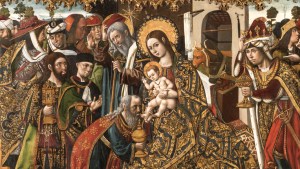There are a number of texts of the early Church that Church Fathers mention in their writings, but which were lost to history until recently. Works like the Didache or the authentic letters of St. Ignatius of Antioch were often quoted or referred to with reverence, but were not recovered intact until the last few hundred years, when ancient copies were discovered on back shelves of libraries. Another of these manuscripts, found only relatively recently, gives us the oldest Easter homily we have.
In 1940, the scholar Campbell Bonner published a translation of the work On the Passover by St. Melito of Sardis. A Jewish convert born into the Greek half of the Roman Empire, St. Melito was a bishop in the western part of Asia Minor who died in the year 180. His works are referenced by St. Clement of Alexandria and St. Jerome, as well as other influential early Christian writers such as Eusebius, Origen, and Tertullian.
By all accounts he was renowned for his holiness and regarded as a prophet (a term still used in the early Church for preachers with a particular charism, c.f., Ephesians 4:11).
On the Passover is a rich example of the way the Church Fathers bridged the Old Testament and New Testament. St. Melito lived in a time where this was actually a controversial idea! Not a few Christians thought that the Old Testament was of no worth to followers of Jesus—His own words saying that He had come not to abolish but to fulfill the law notwithstanding—and some, like Marcion, even went so far as to claim that the God of the Old Testament was a wholly different entity from the God of the New Testament.
The Church Fathers, on the other hand, following the example of the New Testament writers themselves, showed how the life and acts of Jesus were foreshadowed in the Old Testament. In the words of St. Augustine, “the new is concealed in the old, the old is revealed in the new.”

Read more:
If you want to love Mary more, find her in the Old Testament (this book will guide you)
In On the Passover, St. Melito shows the connection between the Passover and the sacrifice of Christ on the cross, using precisely this kind of language. He writes that the “mystery of the Passover is new and old … It is old insofar as it concerns the law, but new insofar as it concerns the gospel; temporal insofar as it concerns the type, eternal because of grace; corruptible because of the sacrifice of the sheep, incorruptible because of the life of the Lord; mortal because of his burial in the earth, immortal because of his resurrection from the dead.”
St. Melito recounts the Passover, when as the last plague against Egypt God sent the angel of death to slay the firstborn, but spared those who placed the blood of a sacrificed lamb over their door post, so that the angel “passed over” their houses. St. Paul had identified Jesus with the Passover lamb (1 Corinthians 5:7), and the Book of Revelation does so almost exclusively, but St. Melito goes so far as to say not only that the Passover lamb was a foreshadowing of Christ crucified, but that in a sense Christ’s saving action on the cross was at work in the first Passover!
St. Melito writes:
Tell me, O angel, at what were you turned away? At the sacrifice of the sheep, or the life of the Lord? At the death of the sheep, or the type of the Lord? At the blood of the sheep, or the Spirit of the Lord? Clearly, you were turned away because you saw the mystery of the Lord taking place in the sheep, the life of the Lord in the sacrifice of the sheep, the type of the Lord in the death of the sheep.
Thus, he writes later: “Therefore, the type had value prior to its realization, and the parable was wonderful prior to its interpretation.”
While not mentioning him, St. Melito is responding to Marcion and those like him who denied that it was the same God acting in both the Old Testament and New Testament. He writes that it is the same one “who made the angels in heaven … who guided you out of Egypt … who came to you, the one who healed your suffering ones and resurrected your dead.”
In this Easter season, as we continue to celebrate the resurrection of Our Lord, St. Melito helps us to see how this event is the culmination of salvation history, which included events in the far distant past, but in which the same Lord was present and active. St. Melito’s writing helps to reveal the new concealed in the old.

Read more:
If you need hope, foster your “Christian memory,” says Francis

